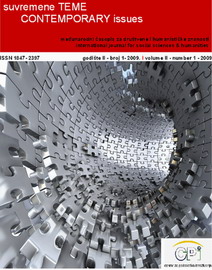Oblik državnog uređenja Bosne i Hercegovine po Cutileirovom planu (18. ožujka 1992.) međunarodne zajednice
International Community Polity Proposal for Bosnia and Herzegovina according to Cutileiro’s Plan (March 18, 1992)
Author(s): Saša MrduljašSubject(s): Politics / Political Sciences
Published by: Centar za politološka istraživanja
Keywords: Bosnia and Herzegovina; Croats; Serbs; Bosnian Muslims/Bosniaks; international community; Cutileiro’s Plan; confederation
Summary/Abstract: During the final phase of the breakup of Yugoslavia, in circumstances which have led to independence of its republics and were largely characterised by Serbian hegemonic aggression towards Croatia, a final chrystallisation of political goals of the three Bosnian-Herzegovinian ethnicites. By the end of 1991, Serbs agree to the creation of a Serbian political entity on two thirds of Bosnian-Herzegovinian territory with a possibility of merging with Serbia. On the contrary, the two other ethnicities opted fo an independent BaH. However, while the Croats saw the future state as a complex (con)federal republic of three national-territorial entities, with the Croatian entity comprising one third of state territory, Bosnian Muslims/Bosniaks seeked a unitary state, which would, considering the conditions of the soon-to-be-reached Bosnian Muslim/Bosniak absolute demographic dominance, function as a de facto Bosnian Muslim/Bosniak national state. In order to coordinate the political goals of the three Bosnian-Herzegovinian ethnicites and to harmonise their mutual relations, the international community started its direct involvement in BaH beginning of 1992, part of which was the drafting of the international/Cutileiro’s plan for Bosnian-Herzegovinian polity. This is the only plan of the international community which was not created in an atmosphere determined by the state of war (April 1992 – November 1995) and the traumatic experiences which impact the post-war political reality of Bosnia and Herzegovina. Due to this fact, the international community and Cutileiro’s plan could take into account the Constitution of the Socialist Republic of BaH which defined the state as a polity governed by three constituent, sovereign and equal ethnicites (Croats, Serbs and Bosnian Muslims/Bosniaks) to a much greater extent. In doing so, the international community could pay equal respect to the needs and whishes of all three ethnicities. The analysis of this plan shows that the international community, wishing to harmonise and stabilise interethnic relations in BaH envisaged a highly integrated confederal state.
Journal: Suvremene teme : međunarodni časopis za društvene i humanističke znanosti.
- Issue Year: 2009
- Issue No: 2
- Page Range: 48-60
- Page Count: 12
- Language: Croatian

